Those born in January, like my wife Anne and my sister Ruth Ann, are fortunate to have the beautiful and diverse garnet as their birthstone. Because red garnet’s use in jewelry dates back thousands of years, many jewelry lovers think of garnet only as a red gemstone. Today’s gem buyers, however, have learned that garnet comes in a rich palette of colors including green, orange, pink, purple, yellow, brown and even blue. Some garnets are also known to change color from blue to purple in different lighting.
While red garnets are widely available, not all garnet varieties are as abundant. For example, tsavorite, a green garnet, is very rare because of the unusual rock chemistry and special conditions required for it to form. Demantoid is another rare and famous green garnet, while spessartine is a rare orange garnet.
Click the link to see the 100 East Fine Jewelry Garnet Collection. We have a variety of shades and colors of garnet to brighten your day! Here are some recent 100 East Fine Jewelry designs:
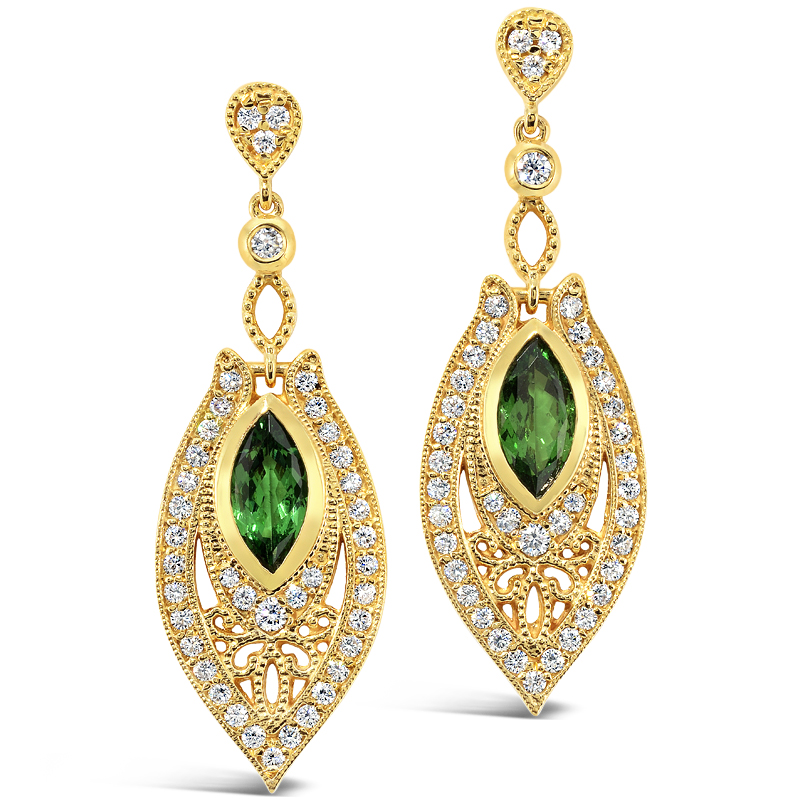
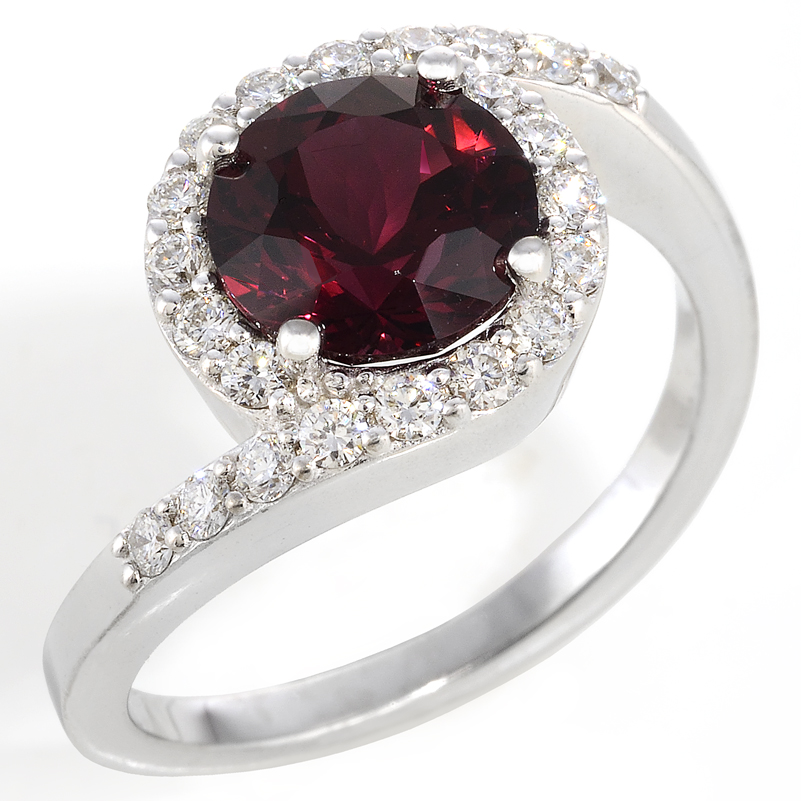
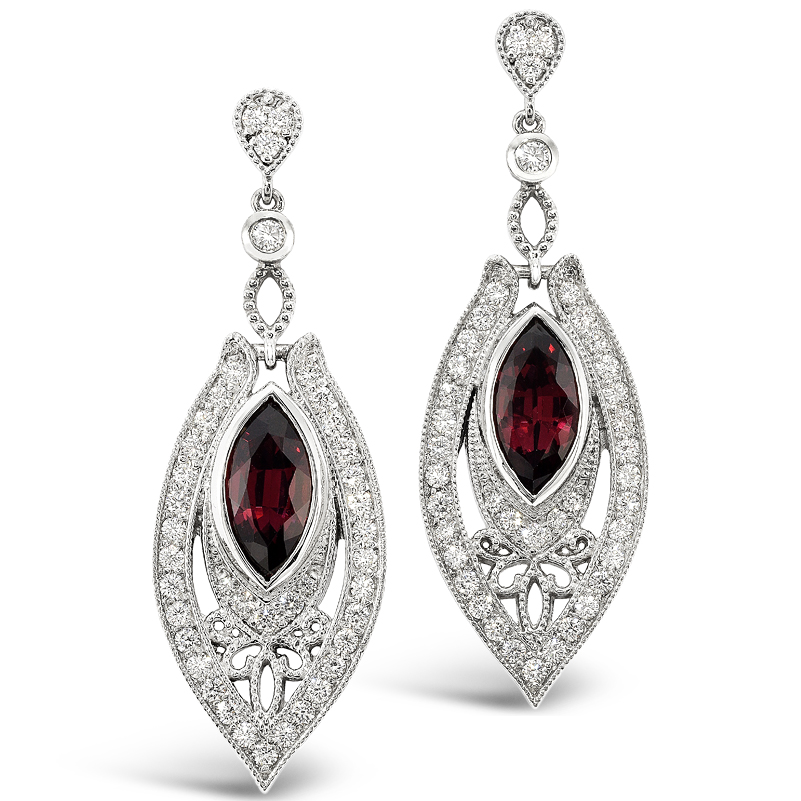
In addition to being the January birthstone, garnet is also the gem for the second anniversary.
History and Lore
As early as the Bronze Age (approximately 3300 BC to 1200 BC), garnets were used as gemstones and abrasives. The mineral continued to be used as abrasives for thousands of years. Red was, and continues to be the most common garnet color. When made into a gemstone, its red hue was reminiscent of the color of pomegranate seeds. Thus, the name garnet was appropriately derived from the early Greek word “granatum,” or Latin granatus, meaning “pomegranate.”
From small tumbled beads put in gold necklaces in Egypt in the 4th millennium BC, to beautifully carved garnet intaglios excavated throughout the vast Roman Empire, it is clear that garnet was very important to those early cultures. Red garnet necklaces adorned the necks of Egypt’s pharaohs, and were entombed with their mummified corpses as prized possessions to be carried into the afterlife. A stylish red garnet bead necklace was found in a grave in Egypt which is estimated to be more than 5000 years old.
Garnets were also popular in Europe around the time of Alexander the Great’s invasion of Persia in the 4th century BC. Ancient Romans used carved garnets in signet rings to stamp wax that secured important documents. Centuries later, during Roman scholar Pliny’s time (23 to 79 AD), red garnets were among the most widely traded gems.
During the Middle Ages (from about 475 to 1450 AD), red garnet was favored by clergy and nobility. Red garnet’s availability increased around 1500 with the discovery of garnet deposits in Bohemia (now part of the Czech Republic). Its mines became the primary source of red pyrope garnets, so popular during Victorian times. The material from those mines became the nucleus of a regional jewelry industry that reached its peak in the late 1800s. However, since that peak, red garnets have generally fallen out of fashion. While garnet had been cherished for its fierce red hues for millenia, it wasn’t until the nineteenth century that garnet’s broader range of colors was discovered. Thanks to this growing array of colors, garnet’s popularity increased, particularly in the 19th and 20th centuries.
Green demantoid garnets, first discovered mid 19th century in Russia’s Ural Mountains, were an immediate favorite of the Russian royal family. Tsar Nicholas II of Russia commissioned his finest artisans to create elaborate jewelry for his wife featuring demantoid garnets. Peter Carl Faberge (1846–1920), the imperial Russian jeweler included demantoid garnets in many of the pieces he made for the royal family. In 1913, Faberge created one of his most impressive and valuable Faberge Eggs, named 'The Winter Egg', which is made of rock crystal, platinum, diamonds and demantoid garnets, among other gemstones.
Near the end of the 19th century, a deposit of orange colored garnet was found in a German mountain range in the Bavarian district of Spessart. The new mineral was named spessartite in honor of the location. Spessartite was so rare that for many years it was owned primarily by collectors. Hardly any was used in jewelry until the 1990’s. In 1991 near the Kunene River bordering Namibia and Angola, a deposit of radiant orange to red spessartites was discovered in Namibia. Just before the turn of the century, another deposit of orange garnet was discovered, this time in Nigeria. These new finds changed the gemstone world.
The vibrant green tsavorite is among the newest garnet discoveries. They were first identified in north-east Tanzania in 1967 by a British geologist. This unique garnet’s popularity took off with additional tsavorite discoveries.
Garnet has also been the topic of significant lore throughout the ages. Red garnets tend to have darker tones and lower saturations of red. Ancient civilizations cut these black looking stones as cabochons and hollowed out the back so the finished gemstone would display a rich red color. These hollow backed gemstones were known as carbuncles. In medieval times, the term carbuncle came to represent almost all red gemstones, but particularly the hollowed out red garnets. A carbuncle stone was considered to possess magical properties, one of which was the capability to light up an otherwise dark interior and offer protection from nightmares. Today, the word carbuncle is still used in the British market to refer to hollow backed garnets. Travelers carried garnet to protect against misfortune when far from home. Some believed garnet brought the wearer good health, wealth and happiness.
Garnet also had reputed health benefits. According to Indian astrology, garnet helped eliminate negative feelings, such as depression and guilt. It was thought to instill greater self-confidence and mental clarity, promote creative thinking and generate peace of mind. In ancient and medieval times, gems like garnet were also thought to be remedies for inflammatory diseases and to soothe the angry heart.
Garnet also signified faith, friendship, loyalty and truthfulness. Believed to calm anxiety, cheer the heart, encourage guidance and inspire creativity, garnet illuminated the bright disposition of those who wore it.
Use in Jewelry Today
Garnet’s numerous species, varieties, colors and sizes in often affordable prices appeal to many in today’s gem and jewelry market. All colors have experienced increasing popularity in recent years. Their high refractive index, which gives them great brilliance, makes garnet a lovely choice for any jewelry piece. The outlook for garnet’s use in jewelry remains positive as prices are still reasonably affordable compared to other similarly colored gems.
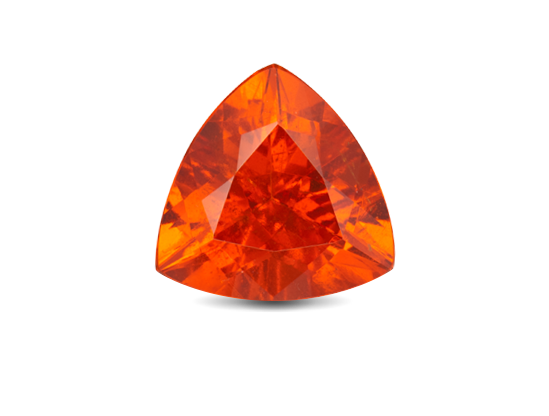
Photo Credit Gemological Institute of America
Gemstones from the garnet group are available in many sizes and weights. However, availability varies depending primarily on variety, with some varieties being rare in large sizes.Demantoid and tsavorite, are more commonly found in smaller sizes, with their value going up significantly with size. Demantoid is very difficult to find in sizes above three carats, while tsavorite can be found in sizes up to ten carats. Rhodolite garnets are very popular and also available in larger sizes. Some other garnets, like almandite, are far more common in larger sizes which means there’s no dramatic rise in price as size increases.
Garnet clarity also depends on its type. The red garnets (almandite, pyrope, and rhodolite) are typically eye clean, meaning they do not have eye-visible inclusions. However, during their formation, red garnet crystals can contain fissures and fractures. The irregular structure of these fissures and fractures can also create weakness in the stone. Breaks, chips or even deep cavities can occur easily during or after fashioning of garnets.
Some orange garnets (spessartite and hessonite) often contain eye-visible inclusions. Grossularite garnet is typically translucent, making it popular for cabochons, beads, and carvings.
While inclusions almost always lower the value of a gemstone, demantoid is an exception to the rule. Not only is it highly sought after for its green color, it is also known for horsetail inclusions. 'Horsetails' are regarded as desirable features, as they indicate the prestigious Russian origin.
Phenomenal garnets are rare. The most common are cat’s eye and star garnets which are dark brownish red and not generally transparent. The cat’s eye and star effects are caused by rutile needles in the pyrope-almandite species. Found in much smaller quantities, color-change garnets are considered exciting collectables for the gemstone connoisseur. Rainbow garnets are considered to be the rarest of all phenomenal garnets. Due to their rarity, these gems are only sold by specialized dealers.
Red garnets, in general, are by far the most available and common, making them among the more affordable garnets. Rhodolite, of the reds, is more popular and commands higher per carat prices than the classic red varieties like almandine and pyrope. Pure orange garnets, such as mandarins, are very popular and command higher per carat prices than rhodolite. The two major green garnets, demantoid and tsavorite, have the highest per carat prices of all commercial garnets due to rarity and market demand.
Red garnets used for jewelry manufacture are most commonly cut in into standard shapes (round, oval, and cushion) and calibrated sizes.Once stones exceed 8 to 10 carats in weight, prices rise dramatically.
With a few minor exceptions, garnet gemstones are suitable for just about any jewelry piece, including those receiving daily wear. They’re generally easy to care for. We believe all your gemstone jewelry is best cleaned with warm, soapy water and a soft brush. We consider this a single, safe method to use for cleaning all gemstone jewelry. For additional details, please read our blog; Cleaning Fine Gemstone Jewelry. To learn about caring for all your fine jewelry, please read our blog; Caring for Fine Gemstone Jewelry.
Color Characteristics and Treatments
Garnet is classified as a group of minerals, which because of its complex structure, is one of the most intriguing of mineral collections. Modern mineralogy identifies 24 different mineral species which comprise the garnet group. Every species within the garnet group possesses the same crystal structure, but differ slightly in chemical composition. Ten species are classified as gemstones, of which only five are considered commercially important. Garnet’s colors include multiple hues of red, rare and valuable greens, as well as pinks, purples, yellows, oranges, browns, blues and even colorless. Gemstones within the garnet group possess high refractive index and display high luster.

Photo Credit American Gem Trade Association
The five commercially important gemstone species are pyrope, almandite (also called almandine), spessartite (spessartine), grossularite (grossular), and andradite. A sixth, uvarovite, is a green garnet that usually occurs as crystals too small to cut, but is occasionally set as clusters in jewelry. Many garnet gemstones are chemical blends of two or more garnet species. Determining how each new gem garnet fits into the six main species is a challenge for gemologists. Since the sheer number of garnet species and varieties can seem bewildering, it helps to think of them in color groupings:
- Pyrope and almandite range from orangy red to purple:
- Pyrope is a strongly purplish red to vivid red.
- Almandite is the most common species, ranging in color from strongly purplish red to red to orangy red. They are primarily dark in tone with a brown modifier.
- Rhodolite is a blend of the pyrope and almandite species. Rhodolite’s color ranges from dark purplish raspberry red to light reddish purple. The best rhodolite is medium to medium dark in tone.
- Spessartite is found in a variety of oranges and yellows, ranging from pale
yellowish orange through bright orange to dark brownish orange.
Mandarin garnet is a pure and vibrant orange color.
- Malaya is a blend of pyrope and spessartite, with a small amount of almandite. Its color ranges from pinkish to reddish orange. It’s name is derived from Swahili and means ‘outcast’.
- Andradite comes in green to yellow-green hues and is best known for the demantoid garnet variety.
- Grossularite may have the widest range
of all the garnet species, from colorless through yellow to reddish orange and orangy red to strong
vibrant green. Major varieties within the grossularite species include:
- Hessonite garnet is the orange to cinnamon colored variety of grossularite. It almost always has a brownish hue.
- Tsavorite garnet is medium to dark yellowish green to green.
- Mint garnet is light to medium yellowish green to green
- Mali garnet is a blend of grossularite and andradite species. Discovered in the 1990’s in the West African nation of Mali, they come in a range of colors from light lime greens to yellow-greens, golden yellows and dark brownish-gold.
Most garnets are not treated. Rarely, however, some treaters try to improve the clarity of the gem by filling surface-reaching breaks or fissures with a glass-like material. This practice is known as fracture or cavity filling. Such treated stones require special care. Avoid exposing fracture filled stones to heat, chemicals, ultrasonic cleaning and changes in air pressure (such as in an airline cabin). Garnets have not been produced in labs by man.
Formation, Mining and Cutting
Minerals making up the garnet family are common in nature, being found in almost every corner of the earth. Garnet is generally found inside metamorphic and occasionally igneous rock, which means its crystals form under high heat and pressure. This process commonly occurs where two tectonic plates converge. Garnet can be found as individual crystals, pebbles, or clumps of inter-grown crystals that are opaque, translucent or transparent in appearance.
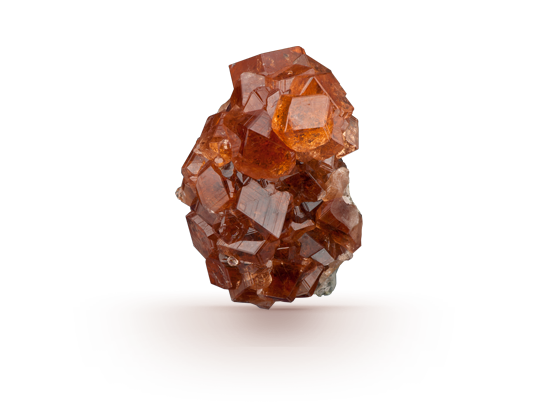
Photo Credit Gemological Institute of America
A reliable supply of garnets exists in the marketplace thanks to relatively recent new material discoveries. Red continues to be garnet's principal color. However, some recent finds, especially in Africa, have expanded and enhanced garnet’s color range. The African continent currently supplies much of the world’s non-red garnet, with other major sources being India, Sri Lanka and South America. Namibia now produces demantoid. Most of the bright green tsavorites come from Kenya and Tanzania.
Different species and varieties of gem quality garnet are often sourced from specific locations. Here are some of the more important ones:
- Pyrope garnet - Brazil, India
- Almandite garnet - Brazil, Myanmar, Thailand, Tanzania, and Mozambique.
- Rhodolite garnet- commonly found in varying quantities and qualities the entire world over. East Africa is currently the most important source, with Tanzania’s well-known Umba River valley the site of the world’s finest rhodolite. India, Madagascar and Sri Lanka are also significant sources.
- Spessartite garnet - The best spessartites at this time come from Namibia and Tanzania, which produce stunning gemstones with strong orange hues. Another beautifully colored orangy yellow spessartite comes from Madagascar. Brazil, the Kashmir region of Pakistan, Sri Lanka, Zambia, India and Nigeria are also sources of spessartite.
- Malaya garnet - This blend of spessartite and pyrope with a small amount of almadite was discovered in Tanzania’s Umba River Valley and remains its primary source. However, additional finds have occurred in Kenya and Sri Lanka.
- Demantoid garnet – vivid green Ural Mountain demantoid gemstones, which owe their color to chromium content, continues to set the standard by which all other demantoid source points are judged. The greatest source of this Russian material is estate jewelry. Mining from the Ural Mountains stopped for some time, but resumed intermittently around the turn of this century. Output is currently describes as ‘only a trickle’. However, demantoid is no longer quite as scarce, thanks to finds in Namibia and Madagascar. Small deposits have also been found in a smattering of countries, including Mexico, Iran, Greece and Italy. African demantoid is less desirable for a couple reasons. It’s a yellowish green, olive green or brownish color, due to higher concentrations of iron, not the vivid green of Russian material. Also, only Russian-sourced demantoid displays the prized trait of ‘horsetail’ inclusions.
- Hessonite garnet– part of the grossularite species, hessonite is mined in Brazil, India, Kenya, Tanzania, Mexico and Sri Lanka.
- Tsavorite garnet– part of the grossularite species, tsavorite is probably the best known green garnet. Tanzania, Kenya and Madagascar are the major sources of tsavorite. Pakistan also contributes small quantities.
- Mint garnet– part of the grossularite species, it is found in Myanmar, India, Afghanistan, South Africa and Zambia
- Mali garnet- The newest of garnet varieties captivated the market with their brilliance. The yellow and green hues, and even brown, which is not the most popular color, appear vivid and natural. Their only known source is Mali.
The majority of garnet found in the US is used for industrial purposes. However, some amazing quality gems have been pulled from US soil.
Skilled cutters around the world turn garnet crystals into all the classic gemstone shapes (round, oval and cushion), but they also increasingly create modern, imaginative designer cuts. Many less expensive garnets, especially red varieties, are cut into the classic shapes in calibrated sizes to allow easy setting into mass market jewelry. Expensive garnets like fine-quality tsavorite are cut into shapes and cutting styles that allow more of the weight to be retained from the rough. Demantoid is often cut to exact proportions that allow the best possible display of its fire. Garnets are also popular for carvings. Red garnets are classic materials for cutting into cabochons and beads.
Famous Garnets
The Smithsonian’s antique pyrope hair comb is one of the most famous pieces of garnet jewelry. A large rose-cut garnet sits at the crest, much like a queen serenely surveying her court. The pyrope garnets that decorate this tiara-like jewel came from the historic mines in Bohemia, and these rich red beauties were extremely popular during the Victorian era (1837–1901), when this piece was fashioned.
Credit to Gemological Institute of America (GIA), American Gem Trade Association (AGTA), Gemworld International

